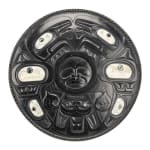-
Artworks
RON RUSS (1953-), MASSET, HAIDA GWAII
Double Sided Dish, early 1980sargillite, bone, and pāua shell, 7 x 7 x 0.75 in (17.8 x 17.8 x 1.9 cm), measurements reflect dimensions without custom metal display stand.
unsigned.LOT 119
ESTIMATE: $3,500 — $5,000
PRICE REALIZED: $3,660.00Further images
This finely crafted Double-Sided Dish reimagines two historic platters featured on pages 102 and 103 in Argillite: Art of the Haida (1980) – one of the first major texts on...This finely crafted Double-Sided Dish reimagines two historic platters featured on pages 102 and 103 in Argillite: Art of the Haida (1980) – one of the first major texts on argillite after Marius Barbeau’s – co-authored by Leslie Drew and Haida carver Douglas Wilson. The side-by-side illustration of these historic platters in such a renowned publication highlights the direct influence of older works on the training and development of younger artists. This dish serves as a tangible link, showing how emerging artists studied and built upon these masterpieces to refine their skills and carry forward established traditions.
On the inside of the dish, Russ draws inspiration from Edenshaw’s Decorative Plate (Canadian Museum of History, VII-B-824). Russ omits the inlaid mollusk shell used around the rim in Edenshaw’s design, instead transferring the optically striking material — bone with inlaid pāua shell in his work —to enhance the raven’s wings, whale’s fins, and both creatures' eyes. Interestingly, Russ utilizes a European style to the Thunderbird’s claws, a feature commonly seen in historic platters but notably absent from the referenced Edenshaw plate.
The convex face of the dish reimagines another plate (CMH, VII-B-826) [1]. Russ has compacted the design to fit the circular form more than was necessary in his translation of the Edenshaw design, adapting the composition to suit the new shape while maintaining its intricate details. Like the verso, this side integrates bone and shell to generate visual contrast. Russ’s most striking change from the historic design is the addition of a central face, which creates a bold focal point.
1. This is most likely the work of Charles Edenshaw as well. While Marius Barbeau attributed it to Tom Price, Wilson Duff believed it to be Edenshaw's, and we concur with Duff's assessment. Notably, both pieces are credited to Edenshaw in his solo exhibition catalogue.
References: See the two works in Leslie Drew & Douglas Wilson, Argillite: Art of the Haida, (Vancouver: Hancock House Publishers, 1980), p. 102 and 103. The second dish work can be viewed at Canadian Museum of History. "Plate" Collections. Accessed 7 Oct 2024, https://www.historymuseum.ca/collections/artifact/59756. The Edenshaw plate can be viewed at Canadian Museum of History. "Plate" Collections. Accessed 7 Oct 2024, https://www.historymuseum.ca/collections/artifact/59755.
Provenance
Acquired directly from the artist by a Private Collection, Canada;
Acquired from the above by the present Vancouver Collection.
Join our mailing list
* denotes required fields
We will process the personal data you have supplied in accordance with our privacy policy (available on request). You can unsubscribe or change your preferences at any time by clicking the link in our emails.






